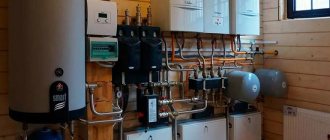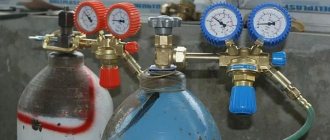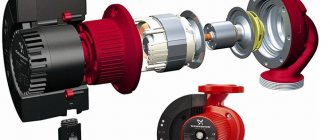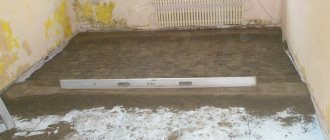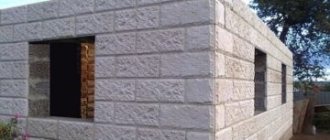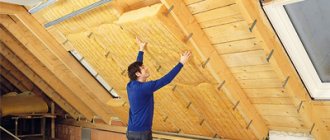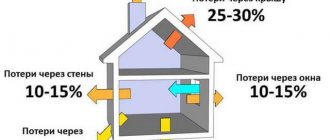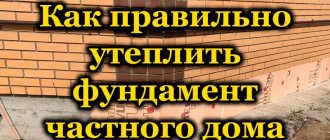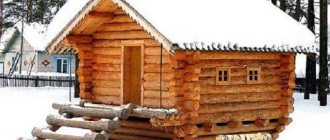- home
- Articles
- Pool insulation
The installation or concrete pouring of a stationary pool in our climatic conditions must be accompanied by thermal insulation. This is due to the fact that even in summer the ground temperature at 1.5-2 meters rarely rises above 10-15 degrees. This causes heat loss, resulting in an increase in energy costs for heating water. In practice, thermal insulation technologies that differ from each other are used, which must be selected taking into account the characteristics of the pool bowl and the surrounding soil.
Insulating the bottom of a concrete pool with penoplex
As you know, the soil temperature, even on a hot summer day, is +7 degrees Celsius, and the desired water temperature is +25 degrees. A concrete pool of any type - heated or not - is characterized by very rapid heat transfer by water. Therefore, when building a concrete pool, it is necessary to build a thermal insulation layer that will inhibit the transfer of heat by water, that is, it will save both electricity and the heat of the water bath you are taking. Do you need to insulate the bottom of a concrete pool? Find out here how to insulate the bottom of a concrete in-ground pool yourself.
Insulation of the pool can be carried out during the preparation of the concrete pour. To do this, a small amount of penetrating substance is added to the solution, which will give the concrete the necessary thermal insulation qualities.
What materials can the platform be made from?
Depending on your capabilities, the pool deck is made from the following materials:
- substrates made of polypropylene, geotextile, linoleum or dense film (such as reinforced) - the simplest and cheapest option;
Geotextile is a moisture-permeable and durable technical fabric used in construction - boards and a waterproof coating on them (the same linoleum or film will do) - it turns out like a podium, this is a more labor-intensive and expensive, but also more durable option;
- concrete or tiles is also a rather expensive and labor-intensive option, but it is the most durable and, as they say, will last for centuries.
Our dacha is located near the forest, in a lowland. There is a swamp nearby. No concrete pillars stay in the ground because groundwater is close. In addition, in the spring the area is flooded with melt water. Therefore, when choosing a site for a swimming pool, we settled on the simplest option: we dug a layer of turf, poured sand that was brought from the river bank, and laid linoleum. The most difficult and time-consuming part was leveling the sand using a long board and level.
Types of insulation
The choice of materials and methods for insulating a pool is very large - from economical to highly costly. The most popular are:
- expanded clay concrete,
- foam plastic or penoplex,
- foam concrete,
- expanded clay,
- foamed polyethylene.
These materials have been tested by time and have confirmed their qualities:
- reliability,
- strength,
- high thermal insulation,
- non-susceptibility to outside influence,
- water resistance,
- environmental friendliness,
- a light weight,
- ease of installation.
Article on the topic: When will swimming pools open in St. Petersburg
? Table of thermal insulation properties of materials:
| Material | Density in kg/m3 | Minimum layer, cm | Thermal conductivity | Hygroscopicity | |
| Bulk | Slag | 1000 | 30 | A | B |
| Expanded clay | 500 | 20 | B | G | |
| Perlite, vermiculite | 40-100 | 10 | D | A | |
| Basalt fiber | 130 | 15 | G | B | |
| Roll | Glass wool | 75-175 | 10-15 | G | B |
| Minvata | 35-125 | 10-15 | G | B | |
| Stitched mats | 75-150 | 10-15 | G | B | |
| Plastif | 50-60 | 2 | G | D | |
| Izover, URSA | 35-125 | 10-15 | G | B | |
| Penofol | 60-70 | 5 | G | IN | |
| Expanded polystyrene | 30-40 | 10 | D | IN | |
| Polyurethane foam | 30-60 | 10 | D | IN | |
| Plate-sheet | Styrofoam | 35-50 | 10 | d | IN |
| Mipora | 25-40 | 10 | D | IN | |
| From mineral wool and glass wool | 75-250 | 10-15 | G | B | |
| Wood fiber | 250 | 1.5-3 | B | A | |
| Foam blocks | Expanded clay concrete | 1000 | 40 | A | IN |
| Foam concrete | 600 | 25 | B | B | |
| Aerated concrete | 400-800 | 20-40 | B | B | |
| Cellular concrete | 400-800 | 20-40 | B | B | |
| Gas silicate blocks | 400-800 | 20-40 | B | B |
A - Very high
D. - Very low
Choosing a roof design
Example of a roof design:
Temperature of gypsum board in this design:
| Air temperature, degrees C | 28 | 28 | 30 | 30 |
| Air humidity,% | 50 | 60 | 50 | 60 |
| Dew point, degrees C | 16,6 | 19,5 | 18,5 | 21,4 |
| Internal temperature surface at (tout = -26C), deg.C | 24 | 25,5 | ||
What is penoplex?
The most famous of polystyrenes is polystyrene foam. Everyone knows its characteristics well, and it consists of inflated polystyrene balls, firmly glued to each other using high-temperature treatment. Penoplex is extruded polystyrene foam - a solid mass that is obtained by pressing through an extruder. Penoplex does not crumble, has a high density, is bendable and, unlike polystyrene foam, does not crumble into small pieces from external influences.
It is this material that is most suitable for insulating the bottom of a concrete pool.
IMPORTANT! When choosing penoplex, take slabs marked “FOUNDATION”. Since this type of penoplex is used in the construction of basements, foundations, as well as insulating septic tanks. The slabs have increased strength and practically zero water absorption coefficient. The density of the slabs should be 29-33 kg/m3.
Features of plastic pools made of polypropylene
Plastic bowls are made from polyethylene and polypropylene. There is no big difference between the materials, since it is one type of plastic. However, most manufacturers prefer polypropylene. Compared to polyethylene, the material has a lower density, which allows you to obtain a finished product with less weight. In addition, polypropylene has greater hardness, which increases abrasion resistance. At a temperature of 80 °C, polyethylene begins to soften. Polypropylene is more resistant to high temperatures. Its softening begins when heated from 140 °C.
In terms of technical characteristics, stationary pools made of polypropylene win. It should be noted that the bowl is only an insert. The base of the pool is poured from reinforced concrete. Sometimes bowls are used as frame fonts. More stiffeners are welded onto them, and when installed outdoors, the water is drained for the winter.
Step-by-step instruction
Insulation of the bottom of a concrete pool with penoplex should be included in the design documentation and carried out in stages during construction work. After digging a pit:
- We pour 3 layers onto the bottom: sand, crushed stone, gravel (15-20 cm each).
- We produce cement screed.
- We make reinforcement (periodic profile reinforcement with anti-corrosion properties).
- We install embedded elements on the bottom: skimmers, water level regulator, flow pipe, outlets from the overflow tray, bottom drain, nozzles, etc.
- We fasten them with anti-corrosion wire. We fence with formwork.
- We cast a concrete slab - the base for the pool.
- Let it dry.
- We lay penoplex.
- We seal and connect with mastic.
- We concrete the base.
- We install the frame bowl or start finishing the concrete bowl.
Article on the topic: Where are the watersheds with the basins of neighboring rivers?
It must be taken into account that the water in the pool is in constant motion, which entails vibration and influence on the bottom of the pool. Therefore, it is necessary to secure the foam blocks very hermetically and in a highly technological manner. It is better to entrust this function to craftsmen who will insulate the bottom in such a way that you do not have to “re-insulate” the bottom of the concrete pool after a couple of seasons.
The cost of penoplex starts from 150 rubles. per sheet.
Construction stages
If you have experience in creating such structures or at least artificial reservoirs, building a pool from polystyrene foam blocks with your own hands will be a completely feasible task. The main stages of the construction work complex are:
- creation of a pit;
- arrangement of a drainage system;
- installation of a water drainage system;
- thermal insulation;
- bottom sealing;
- bottom reinforcement, pouring concrete;
- creating a bowl;
- Finishing work.
In addition to blocks, concrete is used to create the bowl. However, it is much easier to build a pool from polystyrene blocks. Moreover, such structures have better thermal insulation, high strength and a longer service life.
Laying blocks
So, the pit is drained, the drainage line is ready, the reinforced bottom is filled and hardens. Next, we need to lay polystyrene foam blocks around the perimeter of the bowl. The ease of connecting the blocks and the lightness of the material itself make the work quick and productive. And the precision of manufacturing materials will significantly reduce the cost of connecting components.
In order to determine the number of required rows of installation, you need to divide the depth of the pool by the height of the block (25 cm). Before installation, make sure that you leave a niche for the stairs if you planned to install one.
Each polystyrene foam block has special holes for vertical reinforcement. Thanks to this, the process of reinforcing the bowl occurs without any particular difficulties. Next, you need to fill the pool with the mixture and leave it for several days until it dries completely. Afterwards you can begin plastering the walls and finishing. Usually the pool bowl is covered with PVC film or lined with special anti-slip tiles.
As part of insulation
Also, finishing materials or those materials from which the frame pool is made, which will subsequently be inserted into a concrete bowl, can be used as insulating elements. Retains heat well:
- Composite materials.
- Polypropylene.
- Even many types of ceramic or porcelain tiles.
Therefore, before choosing a finishing material, pay attention to its characteristics - thermal insulation and choose the highest coefficient. Many owners of country pools claim that the polypropylene film that covers the inner surface of the pool bowl retains heat well.
Basic requirements for bath insulation
Any insulation for baths and saunas must withstand extreme operating conditions without destruction or loss of properties.
Any insulation for baths and saunas must withstand extreme operating conditions without destruction or loss of properties. High humidity, temperature changes, and heating have a negative effect on most materials.
When choosing thermal insulation, you need to pay attention to the following parameters:
Moisture resistance. If the material absorbs moisture, a complete replacement of the thermal insulation will be required in the next two years. Also, it should not deteriorate with constant contact with water. Despite the vapor barrier, condensation sometimes accumulates between the structural layers. Harmlessness. Bath insulation should not contain harmful or toxic components.
Please note that some substances may decompose when heated. The fumes released can also be dangerous. Ability to withstand repeated changes in temperature and humidity without loss of performance. Fire resistance
It would be good if the thermal insulation is non-flammable or at least self-extinguishing. The bathhouse is a fire hazardous place. If the insulation ignites when heated and burns with an open flame, then every trip to the steam room may be your last.
Thermal insulating properties. The better the insulation retains heat, the less it will be required for construction. Chemical inertness. The insulating layer should not react chemically with other building materials or cause damage to their structure. Biological stability. Warmth and moisture are ideal conditions for the growth of mold, fungi, and putrefactive bacteria. There are modern insulation materials that are not susceptible to contamination by spores. Tightness. The fewer joints the thermal insulation layer has, the better the insulation will be. Elasticity and ability to maintain shape for a long time. These qualities allow you to work on log buildings without installing a frame. This requirement is relevant for insulating bath walls.
It is difficult to say which insulation is better for a bathhouse. Materials are presented in a wide range and in a wide price range. The best is the one whose performance characteristics are at a high level and whose price is affordable. And now more details about each.
How to warm the water in the pool? Personal experience.
Anyone who has a swimming pool on their property is familiar with the problem of heating water. Summer is often cold, even an average pool with 10 cubic meters of water does not warm up, and it is not comfortable to swim. Nobody even dreams about swimming in the fall. In September, everyone already drains the water.
I’ll get ahead of myself - and we’re swimming)) It’s -1 outside. The water in the pool is +35. Class!
So the first stage in the fight against the cold was the greenhouse. Dimensions 5 by 6. The pool fit perfectly. And there is still room for changing clothes and pumps. But alas. By mid-September the water became cold.
I connected a 3 kW electric heater from Bestway. During the week of operation, the water did not warm up at all. The device is complete crap. Threw away.
I started googling and found the Vesnina oven. Heating water with wood. I bought a stove. I made a boiler room for it so it wouldn’t rust. I bought firewood. And he started drowning))
Article on the topic: Is it possible to go to the pool after communion?
So, after heating for one day, I was happy to discover that the ice water became +26. Already a victory! After the second day of heating, the water became like in a jacuzzi +33. And this is already a complete victory!)) By the way, it is advisable to heat it with birch logs. If you burn any garbage, the effect is worse.
To keep the greenhouse warm, I hung up infrared lights. Stable +20. Although during the day if it’s sunny it’s +40 even without them. Due to the greenhouse itself.
Total costs. Greenhouse farmer 70t. Stove 10t. Infrared cameras 2 pieces 6t. Firewood 5t. For boiler room material 5t. All sorts of wires and small items - 3 thousand. About 100 thousand in total.
Are these costs worth it? A friend says you can go to the city pool for the rest of your life for this money. Yes you can, I don’t argue.
But the pleasure and buzz that your own pool gives you, when you are lying in hot water and there is snow outside the window - no amount of money can replace it! So I decided for myself, it’s worth it!))
In the fight against the cold, I burned a bunch of wood until I realized that the problem was not heating, but heat loss. You heat it during the day, but everything cools down overnight... we had to insulate the pool itself. I bought TechnoNIKOL 30mm 12 meters and insulated it all around. I also covered the foam plastic with film in a circle to remove moisture. I bought another awning for the top of the pool. Total two awnings on top, extra. costs +2500 rub.
The insulation solved all the problems. After heating the water to 38 degrees, it lasts for 2-3 days without any heating. After 2 days, the water temperature is +30 degrees. At the same time, it’s -5 outside and +9 in the greenhouse.
What to put a frame pool on?
Almost all owners of summer cottages install a swimming pool in their garden. Moreover, there are now many different models of any size on the market. To install an inflatable pool, you do not need to prepare the site; it is enough that there are no sharp objects, stones or branches on the ground. To install a stationary reservoir, you will need the help of specialists, since this process is very labor-intensive and requires certain knowledge and skills. Many people opt for frame structures; they are more reliable and stable than inflatable pools and cost much less than stationary ones.
Preliminary stage of preparation for purchasing a swimming pool
Before purchasing a pool, you need to study all their possible varieties, advantages and disadvantages. Also evaluate the space of the site. What size pond can you afford to place on it, study the ground surface and think about having the pool in close proximity to the necessary communications. You will need sewer, water and electricity to connect the filter pump.
General requirements for preparing a swimming pool site
The structure of the frame pool must be on a flat, horizontal surface. There should be no dents or irregularities throughout the entire area of the reservoir. It is also important to remove the top layer of vegetation to prevent rotting under the tank.
The soil should be well compacted, and not bulk, so that it does not sag due to the large mass of water in the reservoir.
Loose or bulk soil must be compacted very well. It is best to fill this area with concrete or make an embankment of sand with a layer of at least 20 cm.
It is not advisable to place the structure close to the house, since in the event of an emergency, water can penetrate under the foundation or flood the basement. Ideally, the approach to the reservoir should be free from all sides, although installing it near a fence is not ruled out.
It is not advisable to place the structure under trees, as leaves, branches and insects will constantly fall into the water. The same applies to fruit-bearing bushes. The site must be open.
Types of pools
Pools can be installed both inside buildings and outdoors. Small pools can even be installed in an apartment or house. But in this case, it is necessary to involve specialists who will assess the maximum permissible load, and also ensure normal ventilation of the room, hydro- and electrical insulation. For self-installation, it is better to limit yourself to inflatable or frame pools.
Inflatable pools
They are very simple in design. Lightweight, mobile. Large volume products have an inflatable top edge. They keep their shape due to water and a floating inflatable ring. Their installation is very simple, they do not require special site preparation. You just need to inflate them with a pump, fill them with water and go swimming. As for maintenance, it is necessary to periodically drain the water, clean the reservoir bowl and add chemicals to disinfect and prevent the development of algae.
Seasonal frame pools
These are rod or sheet type structures. They consist of metal rods that are attached to each other with T-shaped joints or plastic sheets that are connected with bolts. A bowl made of three-layer polyvinyl chloride is attached to the frame with special fasteners. These products are intended for installation outdoors or in an indoor transparent gallery for the summer. For the winter, they need to be completely disassembled, washed, dried and stored.
They must be installed on a flat horizontal platform or foundation made of a thick layer of sand.
All-season prefabricated pools
In appearance, they do not differ from seasonal ones, but are made of more durable frost-resistant materials. Their walls are profiled, have a thickness of about 0.8 mm and are covered with several layers of enamel or polymer. Steel sides and a reinforced frame perfectly resist frozen water in the bowl. They can be safely left for the winter, having previously preserved the water.
Usually they are installed on the surface of the ground, or partially or completely dug into a specially dug pit. This installation process is quite labor-intensive and consists of several stages: digging a pit, compacting the soil, concreting the bottom, installing bedding, backfilling and filling the space between the walls of the tank and the backfill wall.
How to properly preserve a swimming pool?
It is better to start preparing the pool for winter when the air temperature is at least +15 °C.
First, without draining the water, clean the bottom and walls of the pool from dirt using a water vacuum cleaner or mop. This must be done with the filter installation turned on.
Then shock treatment is carried out with chemicals, for example bleach or perhydrol. The pump must run for at least 7 hours after administering the medications. Then it needs to be switched to reverse to wash the filter.
After this, the pump is dismantled and the water is drained to the lower water supply nozzles. Disconnect all hoses and put plugs on all holes. All additional equipment is washed, dried and stored.
It is necessary to put compensators in the water that will take on the pressure of frozen water. Plastic cans, polystyrene foam, and tires serve as compensators. They should be located over the entire surface of the water. To prevent them from floating up, you need to attach weights to them, for example, bags of sand.
The final stage of preparing the pool for winter is to cover it with a PVC screen to prevent rodents from getting in and debris and snow from getting in.
Stationary pool
This is the most complex of all structures with equipment for draining and filling water, a filter system. They are located both outdoors and in special indoor areas.
The water in outdoor pools is heated by direct sunlight. Sometimes solar collectors are installed near a pond.
To preserve heat and create a microclimate, transparent covered pavilions are erected or a swimming pool is placed in covered permanent structures, basements, or on the ground floor of the house.
Advantages of frame pools
Modern frame pools consist of a ready-made structure, which is very easy and quick to assemble according to the instructions;
A variety of shapes and sizes allows you to choose a model that will fit perfectly into your landscape design. They are round, oval, rectangular, and octagonal in shape.
They range in size from children to huge family sizes. The largest rectangular pool is almost 10 meters long and 5 meters wide. In such a reservoir you can fully swim, dive, do water aerobics and play sports water games;
The cost of such structures and installation is much cheaper than the installation of stationary pools;
The period of operation of seasonal models is about 10 years. If we are talking about all-season models, then they last much longer;
Not picky about storage conditions. It is enough to wash the structure, dry it and store it in a warm place. Since PVC material hardens at sub-zero temperatures and begins to crack. Frost-resistant models simply need to be properly prepared for wintering;
Preparing a site for a swimming pool is quite simple, the main thing is to adhere to certain rules and steps, which will be described below;
The conditions for maintaining and cleaning the pool are the same as for all types of reservoirs. It is necessary to clean the pool of debris, periodically change the water and clean the bottom and walls of dirt, add chemicals to the water to prevent the development of microorganisms, algae and fungi;
Frame pools have a rich set of equipment. The set includes everything necessary for maintenance and operation: filter pump, ladder, slide, awning, substrate.
The filtration system has the same characteristics as that of stationary pools;
If necessary, you can change the location of the pool without damaging the structure.
The main stages of work on installing a frame pool
Seasonal pools are usually installed on the surface of the ground. It should be level, compacted, free of vegetation and covered with sand. All-season models are partially or completely buried in the ground. To do this, they dig a pit, which should be 1 meter wider than the pool itself.
Main stages of work
First, the area where the reservoir will be located is determined. Its area is measured;
Then markings are made. Pegs are driven into the ground and a rope is pulled;
In this area, the top layer of turf is removed, stones are removed, roots are uprooted;
The soil is well compacted and a leveling layer of sand is made, at least 5-10 cm high. To level, a 3-meter board is placed on the site and a level is placed on it. We trim the protruding soil with a bayonet shovel;
A polyvinyl chloride backing is laid on the sand cushion, and sheets of polystyrene foam are laid on it. The sheets need to be connected together with wide tape. Polystyrene foam boards protruding beyond the perimeter of the pool are cut off with a regular knife;
Then it is covered with polypropylene bedding, which is included in the kit. If you don’t have it in your kit, you can use tarpaulin, polyethylene or even linoleum.
The reservoir structure is assembled according to the instructions. Manufacturers provide not only a printed version, but also a video version.
How to properly dig a pool into the ground?
This is a rather labor-intensive process. First you need to dig a pit 1 meter wider than the pool around the perimeter. The depth of the pit should be from 1/3 to 2/3 of the height of the structure. It depends on the preference of the owners.
Then the bottom of the pit needs to be concreted. The thickness of the slab must be at least 25 cm. A reinforcing mesh must be placed inside so that the concrete does not crack and damage the material of the pool bowl. If the groundwater level is high, drainage will have to be done.
Then sheets of expanded polystyrene are laid. They also line the walls of the tank. Then the process of rebellion begins - the construction of a reinforcing wall made of bricks. This is done so that the material of the bowl does not come into contact with the ground. The rebellion layer also strengthens the frame of the reservoir itself and protects it from deformation.
Installation on wooden floors
It is possible to install a frame pool on a wooden deck. How to do it right?
The boards need to be mounted at intervals of 50 cm, and the supports at a distance of 75 cm;
If the boards are laid on concrete pillars, then waterproofing must be installed;
The boards should be 50 cm longer than the structure itself, so that they protrude no more than 25 cm on each side;
The boards must be etched with an antiseptic.
Pool insulation
The installation or concrete pouring of a stationary pool in our climatic conditions must be accompanied by thermal insulation. This is due to the fact that even in summer the ground temperature at 1.5-2 meters rarely rises above 10-15 degrees. This causes heat loss, resulting in an increase in energy costs for heating water. In practice, thermal insulation technologies that differ from each other are used, which must be selected taking into account the characteristics of the pool bowl and the surrounding soil.
Article on the topic: How can you replace chlorine tablets for a swimming pool?
Materials for pool insulation
Any of the materials used for insulation must meet the following requirements:
- Have minimal water permeability, since the insulation will serve as an additional waterproofing agent.
- Resistant to mechanical damage. Must withstand the loads created by frost heaving of the soil in winter.
- It should allow finishing of the outer surface of the bowl with a minimum number of seams and cold bridges. Only in this case can a minimum thermal conductivity coefficient of the insulating coating be guaranteed.
Thermal insulation of the pool is carried out at the stage of installation or pouring of the concrete bowl. If operations to protect the side walls can be performed later, although this will cost a significant amount, then it will not be possible to protect the bottom of an already functioning structure at all.
Foam concrete
The production of foam concrete at the site where the pool is installed requires the use of specialized equipment for its production.
In addition, unlike ordinary concrete mixtures, delivery by mixer is not possible. Therefore, only ready-made foam concrete blocks (foam blocks) are used to insulate swimming pools. The material has high thermal insulation ability, low weight, and is therefore easy to install. But mechanical strength is characteristic only of structural grades of foam blocks (from D500 and above). Blocks for direct thermal insulation purposes will be destroyed by the soil after a few years, especially if the soil is prone to frost heaving.
In addition, inexpensive handicraft foam blocks often have a high degree of water absorption, so they cannot act as a waterproofing material. And this imposes another limitation, which is taken into account when choosing a material.
Styrofoam
Compared to foam concrete, this material is more attractive and preferable for insulating swimming pools. The only problem is that it is more suitable for structures of the correct shape, which do not have rounded surfaces or non-standard bends. This is due to the sheet structure of the material; it will be difficult to cover a composite bowl of a unique shape with foam plastic.
Article on the topic: How to seal a bestway pool
If we talk about the advantages of this choice, the following factors should be noted:
- Extruded polystyrene foam is widely used for insulating foundations and building structures.
- It is characterized by increased mechanical strength and is able to withstand minor soil displacements during frost heaving.
- The material is absolutely hygroscopic, vapor-tight, and therefore quickly performs the functions of a hydro- and vapor barrier.
Foam boards are placed at the bottom of the pit under the pool and protect the side walls before concrete is poured. It is possible to insulate existing structures. To do this, simply dig around the perimeter of the pool bowl and install sheets. Let us note once again that polystyrene foam is not very suitable for insulating structures with complex shapes.
Thermal insulation membranes
Materials in this category are quite new and have not yet been widely used.
This is due to the conservative approach to business of most builders. But a heat-insulating membrane made of polymer materials copes with the task quite well. It is able to prevent heat leakage into the ground and has minimal vapor and hydraulic permeability. Practice has shown that the heat-insulating properties of such films cannot be called unique. The material is used in conjunction with other insulation materials at the stage of pit construction. Most often, the membrane is laid along the bottom and side walls as a continuous carpet. Carefully seal the joints between the individual panels. To do this, use a special metallized tape, which is used to cover the overlap areas.
The membranes have a long service life and do not rot. With their help, they protect expanded polystyrene and foam concrete from the effects of groundwater. Films of this category are suitable for bowls with complex shapes.
Spray polyurethane foam
This material for thermal insulation of swimming pools is becoming popular. Suitable for most ready-made pools made of polymer and composite materials. Quick and simple surface treatment before installation in a pit provides protection from the effects of groundwater and increases the thermal insulation properties of the walls and bottom of the structure.
Note that insulation with the usual spray foam will be expensive. And this material itself is not very suitable for insulation work. In this area, low expansion polyurethane foam is used. It is characterized by greater mechanical strength, which ensures resistance to mechanical influences from the soil.
Article on the topic: Which vacuum cleaner for the pool lavor swimmy 8.227.0005
The advantages of sprayed polyurethane foam include:
- Possibility of forming an insulating coating without seams or joints. This prevents the formation of cold bridges.
- The shape of the bowl does not matter; polyurethane foam is sprayed onto curved surfaces.
- It has good adhesive properties and has stable adhesion to polymer substrates.
- The material is hygroscopic and performs waterproofing functions.
- Polyurethane foam belongs to the category of fireproof materials; it does not support flaming combustion and goes out without an open source of fire.
Let us note an important point - polyurethane foam is not resistant to ultraviolet radiation, therefore it must be isolated from sunlight. But in the case of processing a surface that is located underground, this problem is no longer relevant.
Foam spraying is also used for the outer surfaces of concrete pool bowls. But after this, the coating is reinforced and plastered using compounds that are resistant to moisture. Often this technology is used as a preliminary step before laying mosaic tiles.
Alternative
Other types of heat insulators are recommended that can perform the same functions:
- Styrofoam. It crumbles and requires laying a hard sheet layer (plywood or chipboard) on top, but otherwise the material can serve as a base for a pool.
- Izolon. This is foamed polyethylene. Rigid varieties with high density differ little in their qualities from penoplex.
- Technoplex, Stirex, Extrol are types of polymer boards whose parameters are similar to penoplex.
- Arbolit. A mixture of wood chips and cement mortar. It has high strength, but is not resistant to water.
- Foam glass. This material retains heat well and is highly durable. However, it is expensive and rarely found on sale.
All materials have their own specific characteristics, so you need to choose carefully, taking into account all the features and factors.
Polyurethane foam insulation technology
The surface of the bowl is treated before installation in the pit. The following technology for performing the work is recommended:
- The walls of the bowl are thoroughly cleaned of dirt and dust.
- When processing particularly critical structures, the surface is additionally degreased. In everyday practice, this stage is usually omitted in order to save money.
- Spraying of polyurethane foam is carried out using specialized equipment.
- The recommended application thickness is at least 5 cm. When laying large layers, a layer-by-layer spraying technique is used after polymerization and pre-hardening of each layer.
- Upon completion of the work, the surface is treated with coating waterproofing, this increases the service life of the coating.
Along with the thermal insulation of the bowl, all communication pipelines are also insulated with polyurethane foam. But in this case, you can not only spray the material, but also use a foam shell of suitable diameter. This method simplifies the work.
Taking into account the specifics of pool insulation technologies and the characteristics of the material, the use of polyurethane foam is considered preferable.
Article on the topic: When will the dolphin pool open in Beloretsk
Thermal insulation of bowl and pipeline
It only makes sense to insulate the bowl and pipeline in stationary pools. Mobile models simply do not need this. The simplest option for thermal insulation of a bowl is the use of polystyrene foam. Sheets of insulation are simply laid around the concrete during pouring.
As a rule, the bottom is not insulated. The average depth of the pool is enough to prevent the water from freezing. Insulating the pool with foam plastic will also protect the structural material from moisture.
Ultimately, this will save the concrete from the freeze-thaw cycle when moisture enters. Polystyrene foam performs an additional function of moisture protection. Sometimes, in addition to polystyrene foam or instead of it, they use expanded clay backfill with a layer 20-30 cm thick.
For thermal insulation of the pipeline, it is better to use shells made of foil and basalt mineral wool. The shell has already been formed to the size of the pipe; all that remains is to insert the pipe into the insulation and seal the joint with foil tape.
You cannot immediately cover the insulation with earth, since fallen clods of dirt and stones can damage the insulating layer. Therefore, a sand cushion is always poured under the bottom of the insulation. Ideally, the pipes should also be filled with sand until the main part is hidden under its layer.
Pool insulation is an important part of the installation work. Thanks to which you can further save money on electricity, and the water in the pool bowl will always be at the same set temperature.
The need for thermal insulation of the pool
One way to extend the life of a pool is to insulate it. There are two types: wall insulation and bottom insulation.
Pool insulation is done for two reasons:
- The temperature difference between the pool bowl and the ground, the water will cool quickly;
- The second reason follows from the first. The energy costs for heating the water in the bowl are too high.
It is necessary to insulate the pool with a material whose thermal conductivity coefficient is quite high. Because the ground temperature is about 5 degrees Celsius, and the pool temperature is 25 degrees. The difference is too great.
Why is the work necessary?
If the pool at the dacha or in a country house is buried in the ground, then thermal insulation is necessary. Usually it is located at a depth of 2 meters.
On the hottest days, the soil at this depth does not warm up above +10... +12 degrees. The difference between night and day temperatures can be more than 10 degrees, which affects the heating and retention of heat at the bottom of the pool. The wear resistance of the bowl deteriorates.
Even if the top layer of water heats up quickly on hot days, the water below will quickly cool down due to the cooled bottom. A layer of insulation will help maintain a comfortable temperature longer. This applies to plastic, concrete, frame and inflatable types of bowls.
Types of pools
Swimming pools come in various types, from special sports and recreational pools to stationary and stationary ones installed at the dacha.
Stationary
Such a pool cannot be moved around the site; a pit is dug under it and formwork is poured for the pool bowl. A place for drainage and water intake is arranged. But there are times when there is no water on the site with which to constantly fill the bowl. In this case, resort to the following solution. At the owner's request, a fire truck is brought in to fill the pool bowl with water. But what about water purification you ask? That's how. A skimmer cleaning system is installed, which, with proper care and proper use of water in the pool throughout the year, the water can not be changed for several years.
Stationary pool
Mobile
This type of pool costs the owner less than a stationary one and does not require year-round maintenance. Only for the summer swimming season. In addition, this type of pool can be moved by the owner to different parts of the summer cottage. In turn, there are several subtypes of mobile pools: inflatable and frame. The first one is one of the simplest. But it is easy to perforate if handled carelessly. The second type is more durable and durable. The water in it can not be changed all season long if a good filter is installed. But unfortunately, you have to face the following problem: many insects, in search of water, find your pool and often drown there. The most unpleasant thing is that wasps can fly in on a hot afternoon and interfere with your rest.
Article on the topic: How to repair a pool pump
What are the requirements for a swimming pool site?
Most temporary pools are very, very demanding when it comes to foundation preparation. And the larger the capacity of the container, the more pronounced these requirements are.
What is most important is the presence of a perfectly flat plane lying in the absolute horizon with a deviation of no more than 2–5 mm per meter. Almost all modular pools are self-supporting, but this property only manifests itself when the load is evenly distributed. Otherwise, the walls will be deformed, and the difference in levels can lead to malfunctions of the water treatment plant.
Both inflatable and frame pools are flexible containers made of water-resistant fabric. A load of several tons of liquid is not a problem for such a tank, but the smallest pebble with sharp edges on the litter may well become one. Of course, in case of minor damage there is a repair kit, but draining 3–5 cubic meters of water is a below average pleasure.
Frame pools are more complex and, in addition to a flat and smooth base, require proper installation of supporting profiles and their fastening in the ground. This may introduce some peculiarities into the foundation preparation process.
Thermal insulation materials for swimming pools
You cannot insulate a pool with any material you like. This will be wasted money. Because it may not be suitable and may not provide the necessary parameters. Let's figure out which material is best.
Thermal insulation membrane
The advantages of this material include:
- Mechanically strong and elastic;
- Meets all hygienic requirements;
- Very little water shedding;
- Easy to install and weld by hand;
- The welding seams are very durable and double thickened;
- Environmentally safe;
- Easy to repair;
- Can be sent for recycling.
Foam concrete
This type of material waterproofs the pool well, as it has:
- low water permeability;
- resists high pressure;
- withstands impact in aggressive water environments;
- is one of the most budget-friendly waterproofers.
Foam concrete - material for pool insulation
Styrofoam
Polystyrene foam is one of the most accessible and inexpensive types of insulation for a swimming pool, which will stop the transfer of heat from the water to the ground. Its advantages include:
- availability;
- little weight;
- environmental friendliness;
- low price;
- high thermal insulation and waterproofing properties;
- does not promote corrosion.
In addition, this material is easy to install and does not require special installations or machines.
Which bedding should I choose?
Often the substrate for an artificial pond comes complete with the tank. If not, then the stores have a large selection of flooring that meets all requirements.
Of course, the finished substrate is, first of all, convenience . But, if you want to save money, you can put a homemade substrate under the tank.
Please note that a purchased pool underlay may not match the brand of the artificial pond.
For frame
Under frame products, a backing made of the following materials is most often used:
It is resistant to precipitation and wind, easy to install, but prone to rapid wear.
For inflatable adult tank
The following types of substrates can be used under a large inflatable pond:
What to put under an inflatable baby bowl?
The following materials are often used as a homemade backing for an inflatable children's pool:
It has excellent heat-retaining properties. It is easy to care for.
For a children's pool, you can use bubble wrap, laid in several layers.
For insulation
The insulation flooring for the tank is of particular importance , because... the earth “takes” a lot of heat. Such a reservoir will cool much faster, and the water at the bottom of the bowl will be noticeably colder.
Typically, summer residents use the following materials for these purposes:
Technological features and advantages of sprayed polyurethane foam
Polyurethane foam is most effective for insulating a house or swimming pool. This is due to its cellular structure. In addition, the cells are filled with carbon dioxide. In addition, the heat transfer coefficient of this material is higher compared to other materials. In this regard, polyurethane foam is superior even to air.
Other advantages of the material:
- spraying does not leave seams through which cold could penetrate;
- spraying can be carried out on structures of various shapes, any configuration and complexity;
- simultaneous insulation and waterproofing is provided by spraying polyurethane foam;
- It is fireproof, as it goes out on its own when ignited.
How to choose material?
When choosing a material, you need to take into account that it must meet certain requirements:
- Perform not only heat-insulating, but also waterproof function.
- Withstand high loads (including being resistant to mechanical damage and withstanding low temperatures in winter).
- A good effect will be achieved by using a material that leaves a minimum number of seams and places for cold penetration.
The best options for insulation would be the following materials:
- Styrofoam;
- thermal insulation membranes;
- sprayed polyurethane foam.
It is not recommended to use materials as insulation that can damage the structure or those where there are many joints left after installation.
Insulation methods and materials
There are slight differences in the insulation of pools made of different materials. Let's take a closer look.
Article on the topic: How to translate into Italian pool
Plastic pool
The pool is insulated by spraying polyurethane foam. You can do this yourself by purchasing a special device. Next, the bowl is placed in the ground or placed in a specially designated room. This type of insulation helps prevent the water in the pool from cooling.
Concrete swimming pool
Insulation is carried out by spraying polyurethane foam. Here it acts as both a heat insulator and a hydro- and vapor barrier. However, insulation must be carried out not only outside, but also inside. To prevent early cooling of the water in the pool bowl. Inside the pool, the polyurethane foam is sanded, reinforced, and then cement mortar is applied. Then everything is decorated with mosaics.
Spraying polyurethane foam - a method of insulating a pool
What can be laid under a piece of pond?
Today, there are no problems with what to put under a piece of pond, since there are many different options for substrates on sale. They are easy to install, protect the bowl well from damage and last a long time. Most often, bedding is already included in the package of a piece of pond, but they can also be purchased separately. If you don’t want to overpay, you can make the backing yourself using available materials: wood, linoleum, etc.
Special substrate
Most often, users of frame pools buy ready-made special substrates, which in some models are already included in the package. They have many advantages:
- meet current quality standards;
- serve for a long time;
- prevent the bottom of the artificial pool from breaking through due to its high strength;
- correspond to the size parameters of the pool;
- easy to install and remove;
- suitable for all-season use;
- are inexpensive.
Special substrates are an ideal solution for small and medium-sized frame pools, which are assembled for the winter at the end of the season. If a piece of pond is installed on a permanent basis, it is better to give preference to more functional and aesthetic substrates made of wood, cement and decking boards. In addition to a reliable design, they make it possible to create a relaxation area next to the pool.
Linoleum
If the pool did not come with a special underlay, but you still have unused linoleum at home, you can lay it under a custom pond. Its properties are close to the required ones: strong, durable, wear-resistant. But there is one significant drawback - when wet, linoleum becomes slippery, which is dangerous. Also, such an alternative looks ugly from the outside.
Polyethylene film
A substrate of this type is well suited for small frame pools, during use of which there will not be a large load on the base. Polyethylene film as a flooring for a piece of pond has a number of significant advantages:
- It is cheap compared to other types of substrates.
- They come in different sizes, allowing you to choose the optimal length and width.
- It is highly resistant to external factors: wind, temperature changes, precipitation.
- It is very light, which gives you the opportunity to lay it yourself without resorting to the help of third parties.
- It has medium strength, which is enough to protect the pool bowl from damage during operation.
Article on the topic: All women are like women and my goddess is a clip in the pool
A significant disadvantage of polyethylene substrates is rapid wear. With normal use, such flooring will be enough for a season, but no more. Sun rays help reduce elasticity, strength and frost resistance. If you do not plan to remove the pond for the winter, this substrate is not suitable for all-season use. You will have to remove the pool frame, replace the deck, and reinstall it every year, which is not practical.
Rolled rubber coating
This coating works well as a substrate for a pool because it retains heat and does not slip. The material is highly resistant to long-term loads and mechanical damage, easy to clean, dries quickly, and is not afraid of temperature changes. Rolled rubber coverings are available for sale in thicknesses from 2 to 40 mm. Thanks to this, you can choose the best option for yourself without overpaying for features you don’t need. Thin models are well suited for children's and single-person pools, while thicker ones are suitable for large ponds.
Installation on wood flooring
Wooden substrate is the optimal solution for both temporary and all-season structures. When you use ponds, you don't have to worry about the bowl being damaged or broken. At the end of the season, the pool frame can be removed for the winter, and the area can be used for other purposes: installing a gazebo, arranging a garden or a creative area.
The underlay is a good solution for both temporary frame pools and those installed for all-season use. With its help, you don’t need to worry that while swimming a pond will break through and flood the area, because ready-made canvases are made of durable materials. If aesthetic beauty also plays a significant role for you, you can design the substrate yourself.
